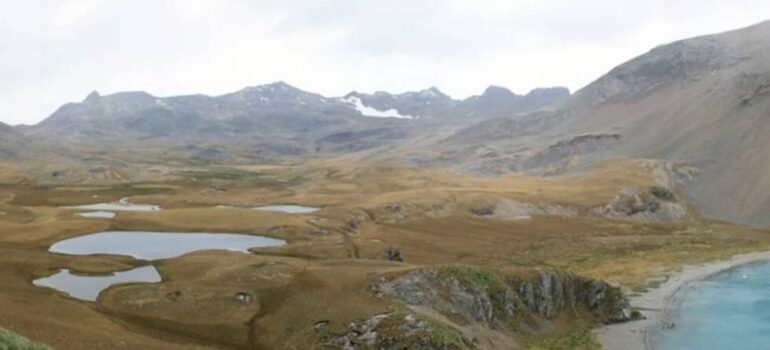Pollen can travel far through the air, allowing scientists who find them to trace the winds of the past. Maaike Zwier writes about her new study from South Georgia, where ancient pollen may reveal shifts in the dominating westerlies.
Winds are important players in the climate system, distributing heat and moisture over the Earth. But for such big influencers, they leave only little permanent traces on the earth itself. This makes it incredibly hard to reconstruct wind systems in the past.
In a new study we used an interesting method to capture changes in surface wind strength over the Southern Ocean for the last 10,000 years: the influx of long-distance transported pollen grains.
Pollen, which behave like very tiny dust particles, can be transported over incredibly long distances by the wind. When they rain out of the atmosphere, they can be captured in sediment archives from lakes and bogs. If the winds are strong and blow faster across the world, the particles will be transported over longer distances.
We found pollen grains from plant species occurring in South America in lake sediments on the remote island of South Georgia, some 1700 kilometers away from the continent.
These pollen grains were transported by the Southern Hemisphere westerly winds, one of the most important wind systems on Earth.

The pollen grains were found in this sediment core from the bottom of a lake in South Georgia. The small holes show where the scientists have taken samples. © Maaike Zwier
By blowing over the surface of the water, these winds drive ocean circulation around Antarctica. Because of interaction between the atmosphere and the ocean, this allows the ocean to take up CO2from the air and transport it to deeper waters. Since the industrial revolution this has led to the Southern Ocean taking up roughly 40 percentof anthropogenic carbon.
The winds also shield Antarctica from warm airmasses from the subtropics, protecting the ice sheet from melting. However, the westerly winds have not always behaved in the same way.
Over long time scales the westerly winds vary in their strength and the core belt has been shifting more north or southwards over the Southern Ocean. These changes influence ocean circulation and the connected climate system. Therefore, researchers are interested in the natural variability of the westerly winds and how this might change in the future with the current global warming.
The sediment record from South Georgia showed that the westerly winds have increased in strength over the last 10,000 years and reached peak strength between 2800 and 1500 years ago. Together with vegetation and climate reconstructions from the island itself, they compare the past wind reconstruction with changes in the local climate.
Periods with stronger winds seem to coincide with colder temperatures on the island. These changes seem to be consistent with findings from studies in Patagonia and the south Atlantic region.
Our findings contribute to the understanding of the climate system in a poorly studied region. These tiny pollen remains provide a promising way of tracing a large wind system in the past. Maybe that wind forecast is not so farfetched after all.
More information:
Maaike Zwier et al, Pollen evidence of variations in Holocene climate and Southern Hemisphere Westerly Wind strength on sub-Antarctic South Georgia, The Holocene (2021). DOI: 10.1177/09596836211060495
Provided by
University of Bergen
Citation:
A strong breeze and chance of storms: A wind forecast from 10,000 years ago (2021, December 14)



